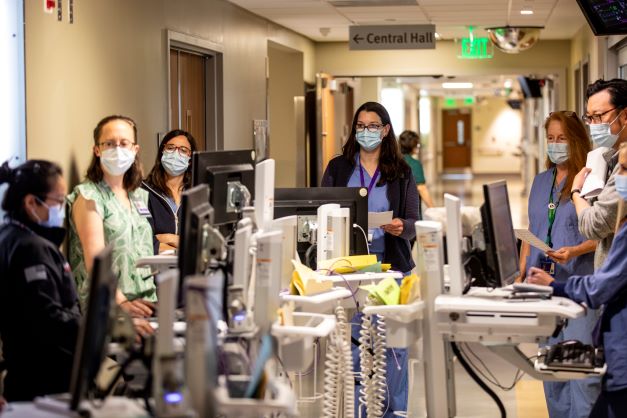
Being a hospitalist during Covid-19
March 4 is National Hospitalist Day – a day set aside to celebrate the amazing clinical work, health system leadership, teaching, and research done by our hospitalists. There are over 120 hospitalists working across the VA, HMC, UWMC-Montlake, and UWMC-Northwest.
As the primary physicians for inpatient services, hospitalists are multitaskers from a variety of medical backgrounds who provide care, teach about and do research for hospitalized patients. During normal operations, hospitalists are busy maintaining the operations of the hospital’s day to day census of patients.
This past year, COVID-19 has completely transformed the day to day experiences of our hospitalists. Our hospitalists quickly implemented safety protocols and prepared for surges of patients. As the pandemic progressed, hospitalists were at the front lines of developing new testing protocols and adapting treatment plans. Care providers had the dual responsibility of caring for those who were sick and of protecting themselves, their colleagues and other patients from transmission.
The efforts of hospitalists and clinical teams in this pandemic are heroic and our heath system and community are eternally grateful. However, we also recognize that throughout this pandemic, caring for our hospitalized patients has never been more difficult or taxing.
While many people shifted to working from home, our inpatient teams came in as usual and often more than just as usual. One hospitalist reflects:
“Everyone else was not going to work, but I was going into the hospital as usual. In a way my schedule changed drastically (changing of shifts/beds to open up more beds for COVID surge), but in a way it didn't change at all (I still woke up and went to work). So, in a sense my work, working as a hospitalist, changed more than other people, and other's work changed far more than mine.”
On the inpatient floor, patients coming in with COVID-19 had to stay in isolation, unable to have family support. They were sick and scared and in need of emotional and physical support. Our inpatient team provided all of this support and more. Many patients shared stories of having other loved ones who also came down with, and sometimes died from, COVID-19. Our hospitalists witnessed firsthand that, while the virus could infect anyone, there were also increased risks and infections amongst those who were already vulnerable.
The emotional weight of the pandemic does not necessarily lift once one leaves the hospital for the day. Our hospitalists and inpatient teams have continued to lift up and support their patients while dealing with the same struggles the pandemic poses in their real life.
This strength and resilience exemplified by our hospitalists, inpatient, and clinical teams throughout this pandemic is an inspiration.
“At the end of the day, we all came together and worked to make multiple vaccines (a scientific and medical feat of such magnitude that is difficult to find a comparison for),” says our hospitalist colleague. “We wore our masks, even if some grudgingly at times, and we all are making it through together.”
If you see a hospitalist in the next few days, please thank them for their contributions to the Department of Medicine. The Society of Hospital Medicine (SHM) has created sharable graphics and posters to help celebrate the day.